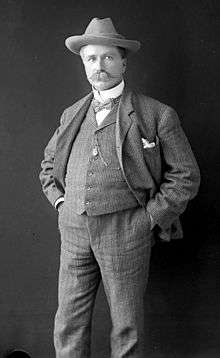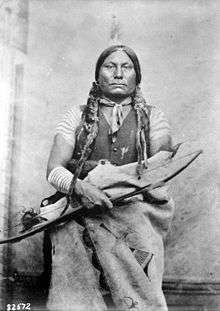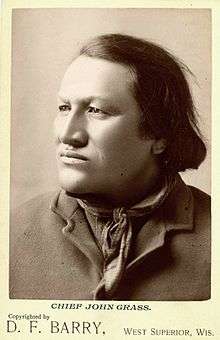David Francis Barry
| David Francis Barry | |
|---|---|
 David Francis Barry 1910 | |
| Born |
6 March 1854 Honeoye Falls, New York, United States |
| Died |
6 March 1934 (aged 80) Superior, Wisconsin, United States |
| Occupation | photographer |
| Nationality | American |
| Genre | Native Americans, Lakota Sioux, early reservation period |
| Notable works | portraits of Sitting Bull, Gall (Phizi), Rain-in-the-Face |
| Spouse | Margaret "Patty" Young |
David Francis Barry (March 6, 1854 – March 6, 1934) was a 19th century photographer of the American West.
Early life
Born in Honeoye Falls, New York, son of Irish immigrants Edmund Barry,[1][2] shoemaker and of Bridgett, née Brophy. In 1861 his family moved west to Otsego, Wisconsin and the following year to nearby Columbus. While growing up in Columbus, Wisconsin David landed odd jobs assisting an itinerant photographer named Orlando Scott Goff who had maintained a small gallery in that city.[3]
Career




In 1871 Orlando Scott Goff moved to Yankton, Dakota Territory opening up the first photographer’s studio in that settlement and two years later relocated to Bismarck. Soon thereafter Goff sent for Barry, his former young helper, taking him under his wings as an apprentice to assist him at his new Bismarck gallery. Over time their friendship grew prompting Goff to make Barry his business partner. Between 1878 and 1883, utilizing a portable photographic studio, Barry traveled throughout the Plains, to Fort Buford and Fort Yates in the Dakotas and Fort Assiniboine in Montana taking photographs as he went. Taken over Goff’s business interests he eventually set up his own studio at Fort Yates and later in Bismarck. Barry made his name photographing Lakota people notables such as Sitting Bull, Rain-in-the-Face, Gall (Phizi), John Grass and others. The Lakota people would nickname him “Little Shadow Catcher”. Barry returned in 1890 to Wisconsin where he operated a successful gallery in the city of Superior until his death in 1934,.[4][5]
Personal life
Barry was married in Chicago on March 27, 1884 to Margaret “Patty” Young of Quincy, Illinois. The marriage remained childless. She died on August 20, 1932. The following year, in 1933 Barry sustained a serious leg injury while stepping off a street car in Duluth, Minnesota from which he would never entirely recover. He died on his 80th birthday at his Superior, Wisconsin home on March 6, 1934.[6]
References
- ↑ Edmund Barry burial place: https://www.findagrave.com/cgi-bin/fg.cgi?page=gr&GSln=Barry&GSiman=1&GScid=1964491&GRid=7546524&
- ↑ Barry Family genealogy: http://worldconnect.rootsweb.ancestry.com/cgi-bin/igm.cgi?op=GET&db=:3188676&id=I627382020
- ↑ Heski, Thomas M., “Little Shadow Catcher: Icastinyanka Cikala Hanzi The Story of D.F. Barry” 1978
- ↑ Heski, Thomas M., “Little Shadow Catcher: Icastinyanka Cikala Hanzi The Story of D.F. Barry” 1978
- ↑ Barry, David Frances, “Plains Warriors, Chiefs, Scouts, and Frontier Personalities” Denver Public Library. Western History Division. David Francis Barry Negative Collection, published 1982 by Paul Harbaugh
- ↑ David Barry burial place: https://www.findagrave.com/cgi-bin/fg.cgi?page=gr&GSln=Barry&GSiman=1&GScid=88065&GRid=6762227&